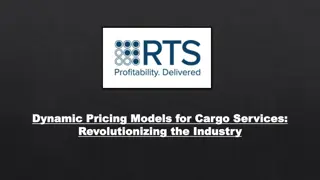
Techniques for Adjusting Cargo Prices Based on Demand, Competition, and Other Market Factors
In the ever-evolving world of logistics and transportation, dynamic pricing has emerged as a crucial strategy for maximizing revenue and optimizing resource allocation. This approach allows cargo companies to adjust prices in real-time based on various market factors such as demand, competition, and other external influences. Here, we delve into effective techniques for implementing dynamic pricing strategies in the cargo industry, focusing on how these adjustments can lead to enhanced cargo revenue management.n
Download Presentation

Please find below an Image/Link to download the presentation.
The content on the website is provided AS IS for your information and personal use only. It may not be sold, licensed, or shared on other websites without obtaining consent from the author. If you encounter any issues during the download, it is possible that the publisher has removed the file from their server.
You are allowed to download the files provided on this website for personal or commercial use, subject to the condition that they are used lawfully. All files are the property of their respective owners.
The content on the website is provided AS IS for your information and personal use only. It may not be sold, licensed, or shared on other websites without obtaining consent from the author.
E N D
Presentation Transcript
Techniques Techniques for Adjusting Cargo Prices Based on Demand, Competition, for Adjusting Cargo Prices Based on Demand, Competition, and Other Market Factors and Other Market Factors
In the ever-evolving world of logistics and transportation, dynamic pricing has emerged as a crucial strategy for maximizing revenue and optimizing resource allocation. This approach allows cargo companies to adjust prices in real-time based on various market factors such as demand, competition, and other external influences. Here, we delve into effective techniques for implementing dynamic pricing strategies in the cargo industry, focusing on how these adjustments can lead to enhanced cargo revenue management. Understanding Dynamic Pricing in Cargo Understanding Dynamic Pricing in Cargo Dynamic pricing, also known as demand-based pricing, is a strategy where prices are not fixed but fluctuate based on current market conditions. For cargo services, this means that the cost of transporting goods can vary depending on factors like shipment volume, seasonal demand, and competitive actions. The primary goal is to align prices with the value perceived by the customer while optimizing load factors and maximizing revenue.
Key Techniques for Dynamic Pricing Key Techniques for Dynamic Pricing 1. 1.Demand Forecasting Demand Forecasting Accurate demand forecasting is the cornerstone of dynamic pricing. By leveraging advanced analytics and historical data, cargo companies can predict future demand trends. This involves analyzing past shipment data, seasonal patterns, and economic indicators. Machine learning algorithms can enhance forecasting accuracy, allowing companies to adjust prices proactively rather than reactively. 2. 2.Competitor Analysis Competitor Analysis Monitoring competitors' pricing strategies is essential for maintaining competitive edge. Cargo companies must regularly track and analyze the pricing models of their rivals. This can be achieved through market intelligence tools that provide insights into competitors' rates and service offerings. By understanding how competitors adjust their prices in response to market conditions, companies can strategically set their own prices to attract customers while maintaining profitability. 3. 3.Customer Segmentation Customer Segmentation Not all customers have the same price sensitivity or shipping requirements. Segmenting customers based on factors such as shipping frequency, volume, and loyalty allows for tailored pricing strategies. High- volume shippers might receive volume discounts, while customers requiring expedited services might face premium pricing. This segmentation ensures that each customer segment is charged appropriately, enhancing customer satisfaction and revenue.
1. 1.Real Real- -Time Pricing Adjustments Time Pricing Adjustments The ability to adjust prices in real-time is a significant advantage in dynamic pricing. By utilizing automated pricing systems, cargo companies can instantly modify prices based on real-time data inputs. This includes changes in fuel costs, weather conditions, and last-minute capacity changes. Real-time adjustments help in filling up cargo space efficiently, avoiding underutilization, and maximizing revenue per shipment. 2. 2.Yield Management Yield Management Yield management involves selling the right product to the right customer at the right time for the right price. In the context of cargo, this means optimizing the balance between load factor (the percentage of capacity used) and the price charged. Advanced yield management systems use algorithms to analyze booking patterns, customer behavior, and market conditions, enabling precise price adjustments to maximize revenue. Benefits of Dynamic Pricing Benefits of Dynamic Pricing Implementing dynamic pricing strategies offers several benefits for cargo companies: Increased Revenue: By charging higher prices during peak demand periods and optimizing load factors, companies can significantly boost their revenue. Enhanced Competitiveness: Staying agile with pricing helps companies stay ahead of competitors who may have more static pricing models. Better Resource Utilization: Dynamic pricing ensures that cargo space is optimally used, reducing instances of empty runs and underutilized capacity. Customer Satisfaction: Tailored pricing strategies can enhance customer loyalty by meeting diverse needs effectively and transparently.
Challenges and Considerations Challenges and Considerations While dynamic pricing offers numerous advantages, it also comes with challenges. Implementing sophisticated pricing models requires significant investment in technology and skilled personnel. Moreover, transparency with customers about fluctuating prices is crucial to maintain trust. Clear communication and justifiable pricing changes can help mitigate customer concerns about price fairness. Conclusion Conclusion Dynamic pricing is a powerful tool in the arsenal of cargo revenue management. By harnessing techniques like demand forecasting, competitor analysis, customer segmentation, real-time adjustments, and yield management, cargo companies can achieve optimal pricing that reflects market conditions and customer value. This not only drives revenue growth but also enhances operational efficiency and customer satisfaction. As the cargo industry continues to evolve, embracing dynamic pricing strategies will be key to staying competitive and profitable. Incorporating these dynamic pricing techniques will ensure that cargo companies remain agile, responsive, and ahead of market trends, securing their position in the competitive landscape of global logistics.
THANK YOU THANK YOU






















